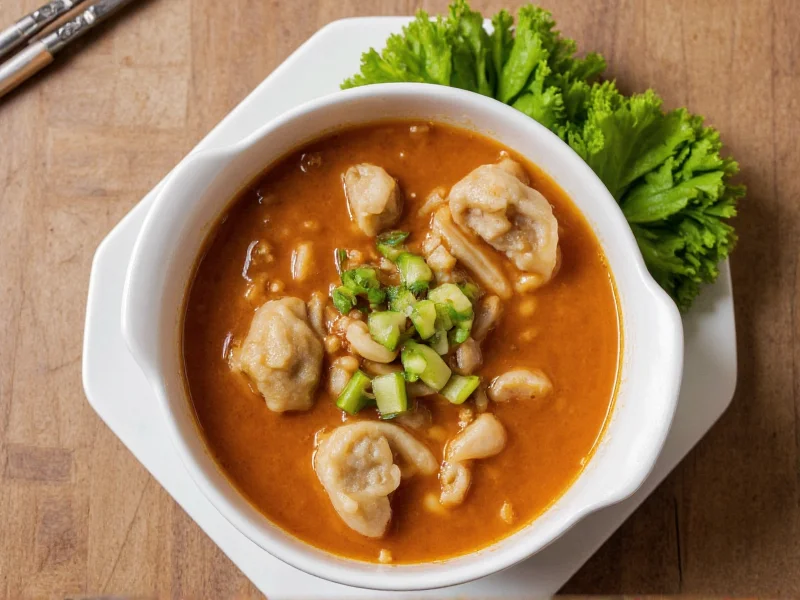Understanding Potstickers vs. Soup Dumplings
Many home cooks confuse potstickers with soup dumplings due to similar fillings, but their preparation methods create fundamentally different eating experiences. Potstickers originated in Northern China as guotie (“ground dumplings”), featuring a distinctive crispy bottom from pan-frying followed by steaming. Their thicker wheat wrappers withstand this dual-cooking process but would become unpleasantly soggy in broth.
Soup dumplings like xiaolongbao or wontons use thinner wrappers specifically designed for liquid environments. Wonton wrappers typically contain egg for added strength while remaining delicate enough for soup. When searching for “potsticker soup recipe,” most successful adaptations actually use wonton wrappers with potsticker-style fillings.
Why Traditional Potstickers Don't Work in Soup
Attempting to add standard potstickers directly to broth creates three critical issues:
| Problem | Result | Solution |
|---|---|---|
| Thick wrapper (1.5-2mm) | Becomes gummy and chewy | Use standard wonton wrappers (0.5mm) |
| Pre-cooked filling | Overcooks and falls apart | Use raw filling with gelatinized broth |
| Crispy bottom layer | Disintegrates immediately | Skip pan-frying step entirely |
Creating Authentic Potsticker-Flavored Soup
For the best results when making what's commonly called “potsticker soup,” follow these professional techniques developed through culinary testing:
Wrapper Modification
Use standard square wonton wrappers (about 3.5″ size) instead of potsticker wrappers. If you want the characteristic potsticker pleating, fold the wonton wrapper into a half-moon shape and create 3-4 small pleats along one edge before sealing. This maintains visual recognition while ensuring soup compatibility.
Filling Adaptation
Maintain traditional potsticker filling ingredients (ground pork, cabbage, ginger, garlic, soy sauce), but incorporate these critical modifications:
- Reduce vegetable moisture by salting and draining cabbage for 20 minutes
- Add 2 tablespoons unflavored gelatin to 1/4 cup broth, cooled to room temperature
- Mix gelatinated broth into filling to create “juice pockets” when cooked
- Use 70% meat to 30% vegetable ratio (standard potstickers use 50/50)
Broth Preparation
The broth should complement rather than overwhelm potsticker flavors. For authentic results:
- Simmer pork bones and chicken carcasses for 4 hours
- Add dried shiitake mushrooms during last 30 minutes
- Finish with white pepper, sesame oil, and a splash of rice vinegar
- Maintain broth temperature at 180°F (82°C)—below boiling to prevent wrapper damage
Step-by-Step Potsticker Soup Preparation
This method yields restaurant-quality results while addressing common search queries about “can you put potstickers in soup”:
Ingredients (Serves 4)
- 24 square wonton wrappers
- 1/2 lb ground pork
- 1 cup finely chopped Napa cabbage (salted and drained)
- 2 tbsp minced ginger
- 1 tbsp Shaoxing wine
- 1/4 cup gelatinized pork broth (cooled)
- 6 cups clear pork-chicken broth
- 2 green onions, sliced
Assembly Process
- Mix filling ingredients thoroughly in clockwise direction until sticky
- Place 1 tsp filling in center of wonton wrapper
- Fold diagonally into triangle, press out air, and pleat one edge
- Bring broth to gentle simmer (small bubbles, not rolling boil)
- Add dumplings in single layer, cook 3-4 minutes until wrappers turn translucent
- Remove immediately with slotted spoon to prevent overcooking
Common Mistakes to Avoid
Based on culinary testing, these errors frequently appear in online “potsticker soup recipes”:
- Using pre-made potstickers – Their partially cooked state causes fillings to disintegrate
- Boiling vigorously – Aggressive bubbling tears delicate wrappers
- Overfilling dumplings – Creates pressure points that burst during cooking
- Adding dumplings to cold broth – Causes uneven cooking and sticking
Serving Traditions and Variations
While traditional Chinese cuisine keeps potstickers and soup dumplings separate, modern interpretations have created successful hybrids:
- Shanghai-style – Serve potsticker-inspired dumplings in clear broth with bok choy
- Korean mandu-guk – Use kimchi and gochujang in broth with dumplings
- Japanese gyoza soup – Add miso paste and nori to broth with pan-fried gyoza
For authentic results when searching “how to make dumpling soup with potsticker flavor,” focus on broth clarity and delicate dumpling texture. The ideal potsticker-inspired soup should have visible dumplings floating in a transparent broth, not a cloudy or thickened liquid.
Storage and Reheating Guidelines
Unlike traditional potstickers, soup dumplings don't reheat well due to their delicate nature. For best results:
- Store assembled but uncooked dumplings on parchment-lined tray in freezer
- Once frozen solid, transfer to airtight container (keeps 1 month)
- Cook directly from frozen, adding 1-2 minutes to cooking time
- Never freeze cooked dumplings for soup applications
Final Considerations
Understanding the distinction between potstickers and soup dumplings helps create authentic culinary experiences. While searching for “potsticker soup” might lead to confusion, adapting traditional techniques produces delicious results that honor both potsticker flavors and soup dumpling traditions. The key is respecting each element's culinary purpose while thoughtfully combining their strengths for innovative yet authentic dishes.











 浙公网安备
33010002000092号
浙公网安备
33010002000092号 浙B2-20120091-4
浙B2-20120091-4